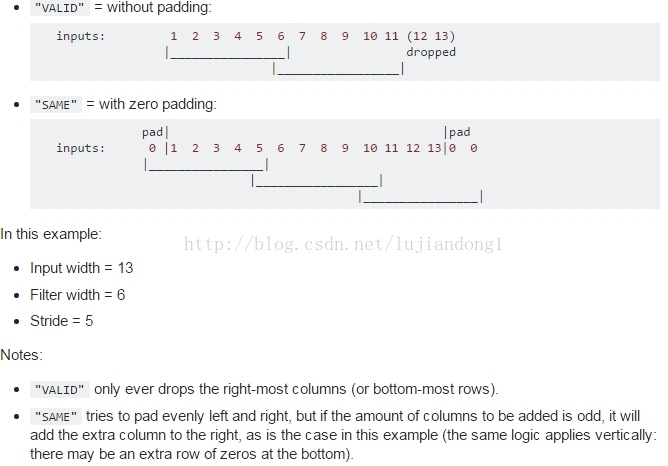作者:杰杰 | 来源:互联网 | 2023-09-01 19:21
1、padding的方式:

说明:
1、摘录自http://***.com/questions/37674306/what-is-the-difference-between-same-and-valid-padding-in-tf-nn-max-pool-of-t
2、不同的padding方式,VALID是采用丢弃的方式,比如上述的input_width=13,只允许滑动2次,多余的元素全部丢掉
3、SAME的方式,采用的是补全的方式,对于上述的情况,允许滑动3次,但是需要补3个元素,左奇右偶,在左边补一个0,右边补2个0
4、For the SAME padding, the output height and width are computed as:
-
For the VALID padding, the output height and width are computed as:
out_height = ceil(float(in_height - filter_height + 1) / float(strides[1]))
out_width = ceil(float(in_width - filter_width + 1) / float(strides[2]))
2、conv2d的参数:
1、strides[0] = strides[3] = 1
3、conv2d的参数解释:
tf.nn.conv2d(input, filter, strides, padding, use_cudnn_on_gpu=None, name=None)
除去name参数用以指定该操作的name,与方法有关的一共五个参数:
第一个参数input:指需要做卷积的输入图像,它要求是一个Tensor,具有[batch, in_height, in_width, in_channels]这样的shape,具体含义是[训练时一个batch的图片数量, 图片高度, 图片宽度, 图像通道数],注意这是一个4维的Tensor,要求类型为float32和float64其中之一
第二个参数filter:相当于CNN中的卷积核,它要求是一个Tensor,具有[filter_height, filter_width, in_channels, out_channels]这样的shape,具体含义是卷积核的宽度,图像通道数,卷积核个数in_channels
第三个参数strides:卷积时在图像每一维的步长,这是一个一维的向量,长度4,strides[0]=strides[3]=1
第四个参数padding:string类型的量,只能是"SAME","VALID"其中之一,这个值决定了不同的卷积方式(后面会介绍)
第五个参数:use_cudnn_on_gpu:bool类型,是否使用cudnn加速,默认为true
结果返回一个Tensor,这个输出,就是我们常说的feature map
4、conv2d的例子:
那么TensorFlow的卷积具体是怎样实现的呢,用一些例子去解释它:
import tensorflow as tf
#case 2
input = tf.Variable(tf.random_normal([1,3,3,5]))
filter = tf.Variable(tf.random_normal([1,1,5,1]))
op = tf.nn.conv2d(input, filter, strides=[1, 1, 1, 1], padding='VALID')
with tf.Session() as sess:
sess.run(tf.initialize_all_variables())
res = (sess.run(op))
print (res.shape)
import tensorflow as tf
input = tf.Variable(tf.random_normal([1,5,5,5]))
filter = tf.Variable(tf.random_normal([3,3,5,1]))
op = tf.nn.conv2d(input, filter, strides=[1, 1, 1, 1], padding='VALID')
with tf.Session() as sess:
sess.run(tf.initialize_all_variables())
res = (sess.run(op))
print (res.shape)
说明:
1、使用VALID方式,feature map的尺寸为
out_height = ceil(float(in_height - filter_height + 1) / float(strides[1]))=(5-3+1)/1 = 3
out_width = ceil(float(in_width - filter_width + 1) / float(strides[2])) = (5-3+1)/1 = 3
所以,feature map的尺寸为3*3
2、filter的参数个数为3*3*5*1,也即对于输入的每个通道数都对应于一个3*3的滤波器,然后共5个通道数,conv2d的过程就是对5个输入进行点击然后求和,得到一张feature map。如果要得到3张feature map,那么应该使用的参数为3*3*5*3个参数.